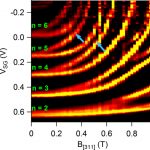
Zeeman splitting of 1D subbands in an out-of-plane magnetic field. These data also show evidence for an anticrossing, as indicated by the blue arrows. The subbands also exhibit a curvature to higher energies due to the additional magnetic confinement.
Spin-orbit interaction (SOI), is the interplay between electrons’ inherent angular momentum (their quantum spin) and their orbit around an atom’s nucleus. This interaction is key to the function of topological materials, which are studied at FLEET for their potential to form ultra-low resistance pathways for electrical current.
A recent study investigated the relationship between spin-orbit interactions in gallium arsenide quantum point contacts.
The study showed that we can detect the signatures of two known forms of spin-orbit interaction in quantum point contacts, and even control their interplay by changing the orientation of the substrate.
The study was published in APS Physics’ Physical Review Letters in April 2017.
Three participating authors are chief investigators within FLEET: Oleg Sushkov leads theoretical investigations of artificial nanofabricated materials and laterally modulated oxide interfaces. He also studies theoretical many-body interactions in exciton condensates and cold atoms. Oleh Klochan leads fabrication and measurements of artificially designed topological insulators using conventional semiconductors. Alex Hamilton leads Research Theme 1, in which he directs the study of artificially engineered topological materials.
This work was supported by the Australian Research Council under the discovery projects scheme and was performed in part using facilities of the New South Wales Node of the Australian National Fabrication Facility.

